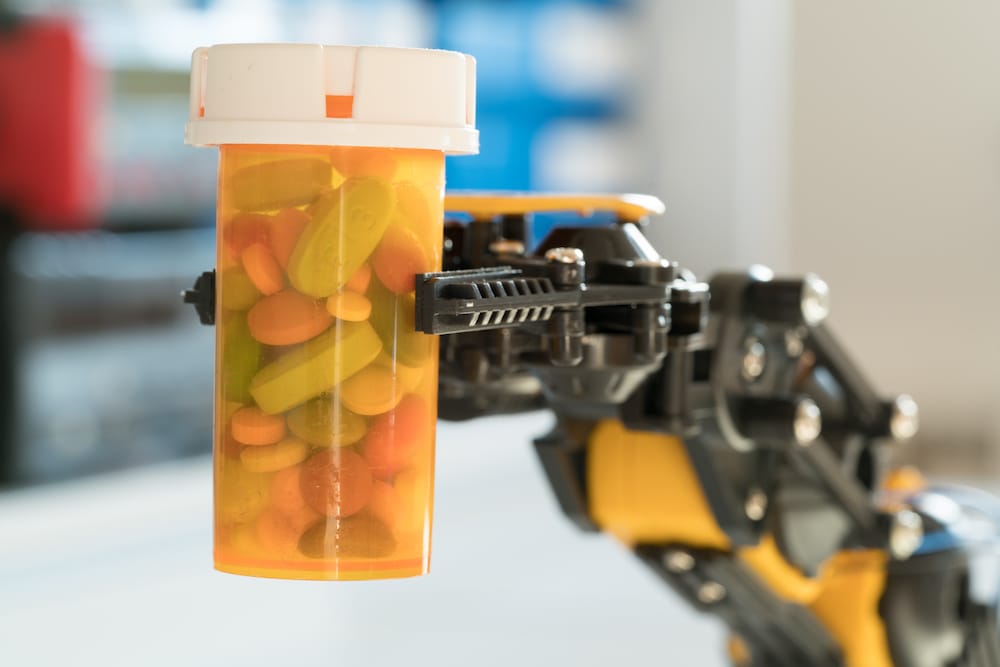The onset of the Covid-19 pandemic has had a resonant impact on advancements in automation technology. Sudden need for touchless and virtual solutions has compelled companies to transform – or invent – whole suites of digital tools to stay seamlessly connected to clients and customers. The healthcare and pharmaceutical industries, certainly at the forefront of the pandemic, have met the demand with remote-based solutions like telemedicine and touchless prescription pickup.
Two years later, convenience and 24/7 access remain a priority for consumers who’ve come to build their schedules around their time, not retail hours. Enter the pharmacy robot, a breakthrough technology that’s been around for over a decade but has resumed the spotlight these days for its improved ability to keep errors down, dispensation rates up, and customers happy.
Expansion of robot-powered fulfillment is also picking up steam at a time of significant pharmacy labor shortages, helping to take off pharmacists’ plates some of the basic inventory and bottling tasks that contribute to burnout.
Pharmacy robots use artificial intelligence (AI) to automate filling and dispensary tasks. In the years since the technology debuted, automated drug dispensing or delivery has shown a reduction in fulfillment times, cost savings, increased precision in drug preparation, and higher prescription volume.
Above all, though, robotic collaboration frees pharmacists to practice the clinical services, counseling, and medication management that are so critical to a patient’s health. Current trends within the automated drug fulfillment space point to a successful dialogue between institutional objectives and prioritization of patient satisfaction.
A Renewed Focus on Patient Education and Satisfaction
Educating a patient on the side effects of a drug is a crucial step in avoiding drug abuse, unwanted side effects, and prevention of adverse drug events (ADEs). While some of us may overlook the counseling portion of the prescription-fill process – it typically occurs during pickup, when the pharmacist explains usage and asks if you have any questions – this conversation has major implications for the patient. Patients have the opportunity to clarify where a prescription fits into their broader medication regimen, so they can leave with an understanding of any risks associated with mixing meds. From the pharmacist’s perspective, counseling is important to verify that the drug prescribed is for the condition the patient is seeking treatment for. This ensures that the medication is written by a physician and dispensed by a pharmacist correctly.
At the same time, pharmacists are expected to maintain high prescription volume and short wait times –factors that contribute to overall “patient satisfaction.” Robots to the rescue: A 2021 study on robotic pharmacy implementation and outcomes in Saudi Arabia found a 53% reduction in average wait times, a 20% increase in patient satisfaction regarding wait times, a 22% increase in overall patient satisfaction regarding pharmacy services, and a 33% increase in pharmacist productivity.
By law, pharmacists must offer counseling to patients about their prescriptions. With pharmacy robots, this exchange is liberated from the traditional retail location and can be conducted anywhere prescriptions can be picked up, like kiosks. In outpatient and retail store settings, kiosks allow for easy and secure prescription pickups during and after hours and provide impactful contactless, “on-call” access to pharmacist consultation services. According to this U.S. study, conducted over three years, patients who used kiosks to pick up prescriptions had fewer questions at the end of a consultation than those who filled their prescriptions at a retail counter. Almost all pharmacists involved in the study said they were effectively able to counsel patients both at the kiosk and the counter. Notably, convenience was cited as a reason for using the kiosk – an indicator of where patient expectations lie in 2022.
Prioritizing Safety and Encountering Challenges
Make no mistake, pharmacy robots don’t have sole discretion over prescription fills from stock to delivery. A pharmacist will always make a final visual verification check before handing it off to the customer, to ensure the medication in the bottle matches what’s on the label. This is one of several safeguards in place for pharmacists to prioritize patient safety.
There are other times a pharmacist may need to intervene. For example, not all medications can be dispensed by a robot: Oral solutions, suspensions, topical products, and compounds are prepared and dispensed by pharmacy staff. Similarly, pharmacists must take care to check that robots are packaging the medications they should be.
As with any machine, there’s a risk of breakdown. Pharmacists should always be ready to manually step in to avoid disrupting the flow of patient care. The dispensing of Schedule II drugs is another challenge in this regard: Many pharmacies may be hesitant to have a robot fill Schedule II drugs in case the machine runs into problems and the medication has to be wasted.
AI’s Wider Impact on the Pharma Industry
So a robot can sort, count, and fill prescriptions. But can it “learn” side effects and communicate them to a patient? Can it answer follow-up questions from the patient? The answer is yes and no.
In some settings, robots have been utilized by pharmacists as an interactive education tool to improve education and enhance self-management for patients. In a small-sample evaluation of robot-assisted diabetes care among the elderly, both patients and pharmacists expressed positive feedback after a 20-minute care session with a robot. But the patients’ self-efficacy stats lagged – that is, some felt they could not get the answers they wanted from the robot in order to feel totally confident.
Two-way conversations between pharmacy robots and human patients may be a ways off, but the wider potential of AI technology in the pharmaceutical industry is vast. Predictive modeling can be applied to manufacturing processes to determine in real-time when machines are deviating, helping to prevent machine failure and perfect operations. In the innovation space, one company is at work on a digitally-enhanced bottle that can track how frequently a patient takes their medication and adjust treatment accordingly.
As digital transformation continues to impact Americans’ everyday lives in a post-pandemic world, we can look to robot-powered fulfillment in the pharmaceutical industry as an example of an automated process that’s creating more room for human interaction. While challenges to seamless operation remain, patient satisfaction surveys indicate a more positive customer experience can be had when robots handle dispensation and pharmacists are free to practice the health-affirming clinical services they’re known and trusted for.
Dr. Reema Hammoud is the Assistant Vice President of Clinical Pharmacy for Sedgwick.








